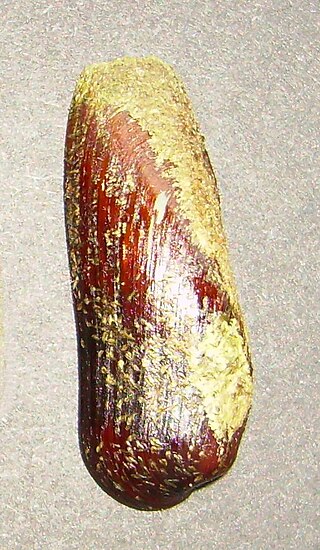
Lithophaga, the date mussels, are a genus of medium-sized marine bivalve molluscs in the family Mytilidae. Some of the earliest fossil Lithophaga shells have been found in Mesozoic rocks from the Alps and from Vancouver Island.

The wildlife of Cape Verde is found across its archipelago of ten islands and three islets, albeit in smaller numbers of species than mainland Africa. Each volcanic island within the archipelago is unique, and each of them have parks under their jurisdiction, by decree promulgated by the Cape Verde government. Located just off the west coast of Africa, the total land area of the island nation is 4,564 square kilometres (1,762 sq mi).
With the exception of bats, there are no truly endemic species of mammal on Cabo Verde; historically, the archipelago was only accessible to creatures with the ability to fly or swim, or to be brought by humans. The islands were first explored in 1456, but not actually settled until 1462; humans brought their livestock with them, including donkeys, pigs, cattle and goats—many of the latter are now so wild, they resemble mainland ibex, and are considered endemic “by default”.
In the centuries since settlement began, more mainland species would make their way with waves of settlers. There are no snakes present on the archipelago, which has allowed for the proliferation of many other species of other herpetiles, such as geckos, frogs and lizards. The main predators of these reptiles and amphibians would be the various birds of prey and raptors present, including the Egyptian vulture, Eurasian buzzard, kestrel, osprey, peregrine falcon, and the rare Cape Verde kite. This kite species is currently threatened by extinction but may yet be observed on Boa Vista and Maio.

The Tropical Atlantic realm is one of twelve marine realms that cover the world's coastal seas and continental shelves.
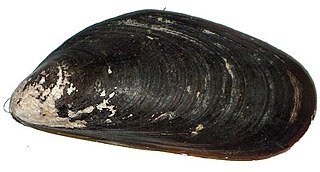
The Chilean mussel or Chilean blue mussel is a species of blue mussel native to the coasts of Chile from Biobío Region to Cape Horn. Today genomic evidence confirmed that the native Chilean blue mussel is genetically distinct from the Northern Hemisphere M. edulis, M. galloprovincialis and M. trossulus and also genetically different from Mytilus platensis,the other species of smooth shelled mussel from South America.

Lithophaga lithophaga, also known as date shell or date mussel, is a species of Bivalvia belonging to the family Mytilidae.

Mytilopsis leucophaeata is a species of small bivalve mollusc in the false mussel family, Dreissenidae. It is commonly known as Conrad's false mussel or the dark false mussel.

Modiolus americanus, or the tulip mussel, is a species of bivalve mollusc in the family Mytilidae. It can be found along the Atlantic coast of North America, ranging from North Carolina to the West Indies.
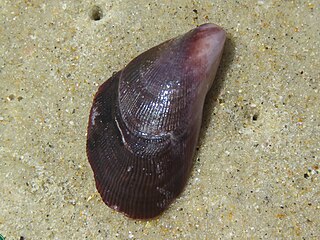
Brachidontes exustus, commonly known as the scorched mussel, is a species of bivalve mollusc in the family Mytilidae. It can be found along the Atlantic coast of North America, ranging from Cape Hatteras to the West Indies and Brazil.
Gregariella coralliophaga, or the Artist's mussel, is a species of bivalve mollusc in the family Mytilidae. It can be found along the Atlantic coast of North America, ranging from North Carolina to the West Indies.
Musculus lateralis, common name the Lateral mussel, is a small species of bivalve mollusc in the family Mytilidae. It can be found along the Atlantic coast of North America, ranging from North Carolina to the West Indies and Brazil.

Botula fusca, or the Cinnamon mussel, is a species of bivalve mollusc in the family Mytilidae. It can be found along the Atlantic coast of North America, ranging from North Carolina to the West Indies and Bermuda.
Lithophaga antillarum, or the Giant date mussel, is a species of bivalve mollusc in the family Mytilidae. It can be found along the Atlantic coast of North America, ranging from southern Florida to the West Indies and Brazil.
Lithophaga bisulcata, or the Mahogany date mussel, is a species of bivalve mollusc in the family Mytilidae. It can be found along the Atlantic coast of North America, ranging from North Carolina to the West Indies and Bermuda.
Lithophaga nigra, or the Black date mussel, is a species of bivalve mollusc in the family Mytilidae. It can be found along the Atlantic coast of North America, ranging from southern Florida to the West Indies.
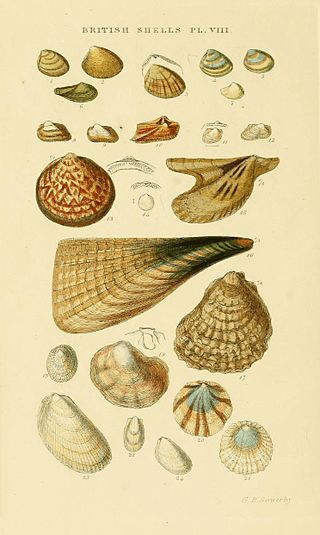
Limaria pellucida, the Antillean file shell, is a species of bivalve mollusc in the family Limidae. It can be found along the Atlantic coast of North America, ranging from North Carolina to the West Indies.
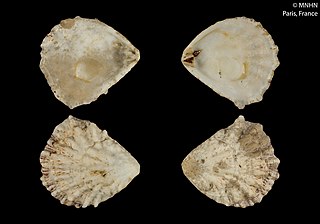
Plicatula gibbosa, commonly known as the Atlantic kitten's paw, is a species of bivalve mollusc in the family Plicatulidae.

Lucina amiantus, or the decorated lucine, is a species of bivalve mollusc in the family Lucinidae.
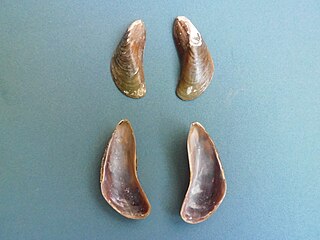
Mytella strigata is a bivalve, commonly known as the charru mussel or charrua mussel. This species was described by Sylvanus Charles Thorp Hanley based on a specimen from the Philippines. It was found in Central and South America and by Alcide d'Orbigny, a French naturalist, in 1842, where it was assigned the synonym Mytilus charruanus. They are less than an inch long (2.5 cm), and range from brown to black in color.
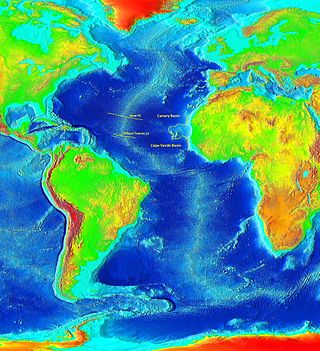
The Cape Verde Rise is an oceanic feature that includes the Cape Verde Islands and the areas north and east of the islands and west of the African Continental Shelf as well as Mauritania and Senegal.














